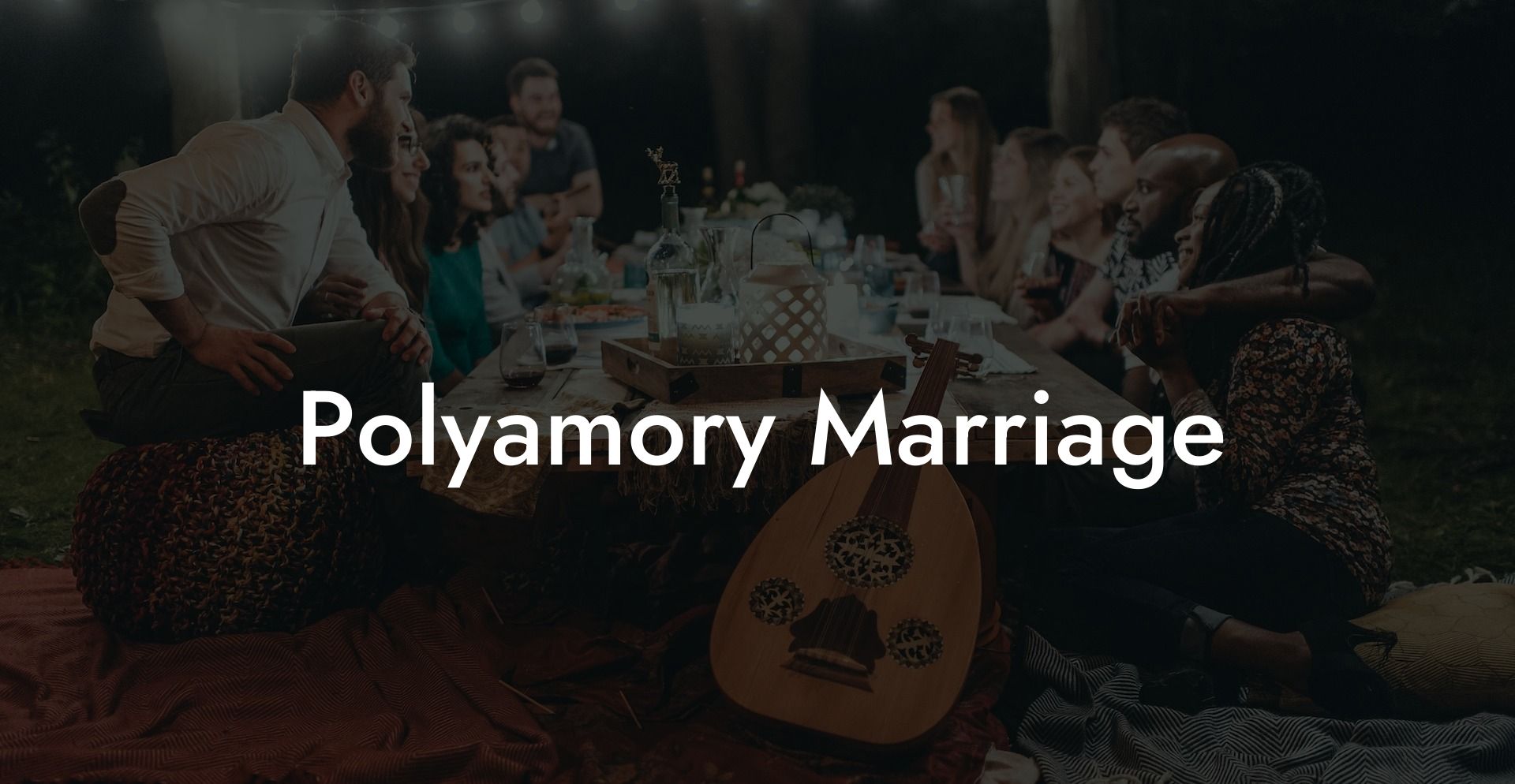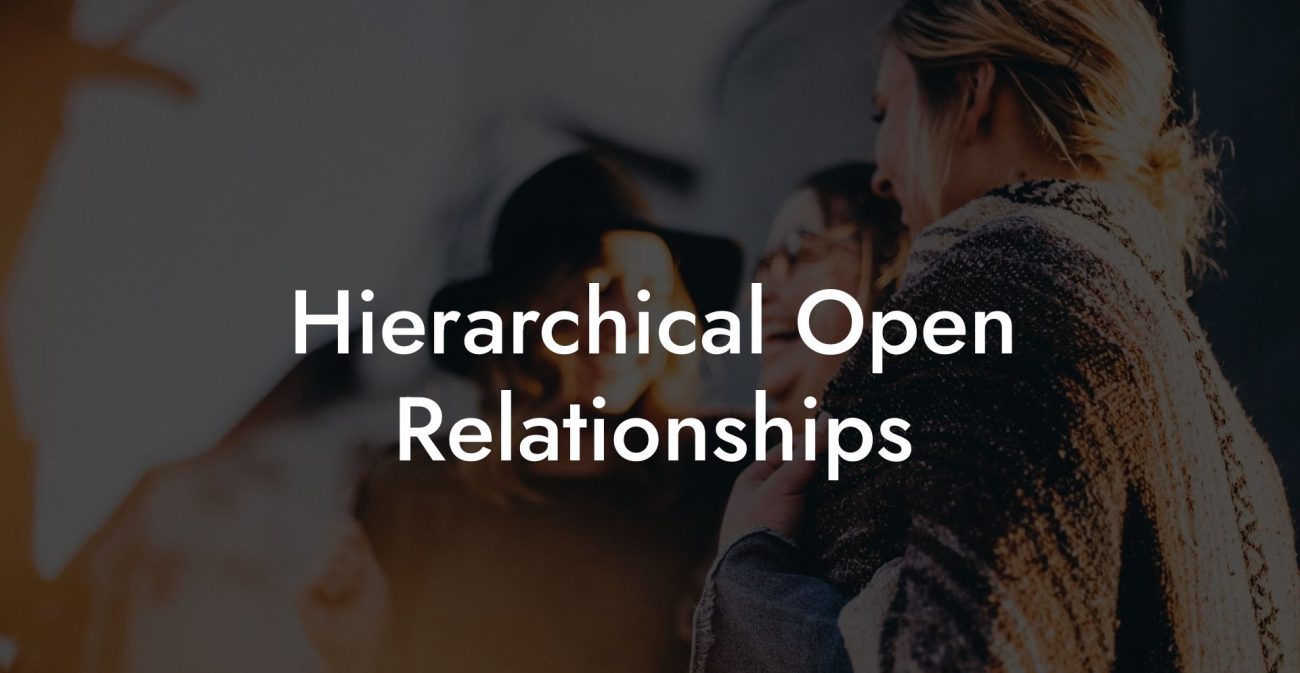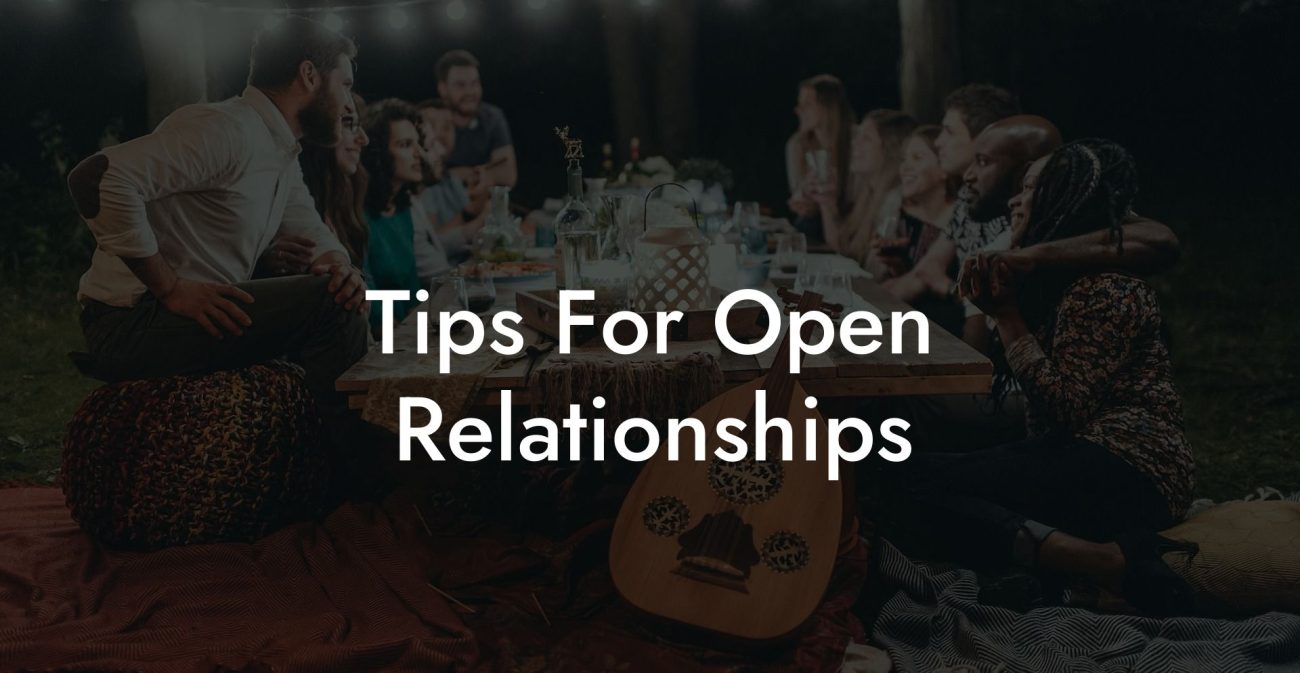Guide to Polyamory Marriage

Imagine a sprawling metropolis of hearts where every relationship is a vibrant, pulsating mural painted with bold strokes of passion, creativity, and daring individuality. In this dazzling city of connection, polyamory isn’t a compromise, it’s a radical reimagining of love, a rebellion against the confines of traditional monogamy. This guide to polyamory marriage is your passport to exploring how multiple, consensual, and deeply fulfilling relationships can coexist, flourish, and evolve into a living masterpiece of commitment. Get ready to embark on a journey that will challenge everything you thought you knew about marriage, as we dive into the philosophy, principles, benefits, challenges, and strategies for thriving in a polyamorous marriage.
Quick Links to Useful Sections
- Understanding Polyamory Marriage
- What Is Polyamory Marriage?
- The Philosophical Foundations of Polyamory Marriage
- Challenging Traditional Notions of Love
- The Role of Ethical Principles in Polyamory Marriage
- Core Principles of Polyamorous Marriage
- Open Communication and Regular Check-Ins
- Establishing Clear and Flexible Boundaries
- Mutual Consent and Continuous Reaffirmation
- Flexibility, Adaptability, and Emotional Self-Awareness
- Benefits of Polyamorous Marriage
- Diverse Emotional Fulfillment
- Opportunities for Personal Growth
- Enhanced Communication and Conflict Resolution Skills
- Flexibility and Creative Relationship Structures
- Community and Social Support
- Challenges of Polyamorous Marriage
- Managing Jealousy and Insecurity
- Time and Energy Constraints
- Constantly Evolving Boundaries
- Social Stigma and External Pressures
- Strategies for Success in Polyamorous Marriage
- Establish Regular Communication Routines
- Set Clear, Flexible Boundaries
- Leverage Digital Tools for Organization
- Invest in Self-Care and Personal Growth
- Build and Maintain a Supportive Community
- Seek Professional Guidance When Needed
- Real-Life Success Stories
- Case Study: Alex and Morgan’s Journey
- Case Study: Jamie’s Transformation Through Self-Reflection
- Expert Insights
- FAQ: Your Polyamory Marriage and Rules of Engagement Questions Answered
Understanding Polyamory Marriage
What Is Polyamory Marriage?
Polyamory marriage is a consensual relationship model where individuals form long-term, committed bonds with more than one partner. Unlike the traditional notion of marriage that enforces exclusivity, polyamory marriage celebrates the idea that love is not a finite resource but rather a renewable, expansive force that can be shared among multiple people. In this model, every partner is fully aware of the multiple relationships at play, and each connection is nurtured with open communication, respect, and mutual consent.
In a polyamorous marriage, the focus is on creating a network of relationships that each contribute uniquely to your emotional, intellectual, and physical well-being. Whether you designate one connection as “primary” and others as “secondary,” or choose to treat all relationships as equally important, the underlying principle is that every bond has its own value. It’s a model that embraces both the diversity of human connection and the complexity of individual needs.
The Philosophical Foundations of Polyamory Marriage
Challenging Traditional Notions of Love
At its core, polyamory marriage rejects the outdated idea that true love can only exist between two people. Instead, it posits that love is an inexhaustible resource that grows the more you share it. This philosophical stance is built on the belief that each relationship adds a unique hue to the mosaic of your life, and that no single bond can fulfill every aspect of your emotional landscape.
This paradigm shift allows you to redefine commitment on your own terms, choosing how much time, energy, and intimacy to invest in each relationship. It liberates you from the pressure of finding “the one” and opens the door to a more expansive, fulfilling experience of love that can adapt to the complexities of modern life.
The Role of Ethical Principles in Polyamory Marriage
Successful polyamorous relationships are built on a foundation of ethical non-monogamy. This means that all relationships are formed and maintained through free, informed consent, and ongoing, transparent communication. Key ethical principles include:
- Free Consent: Every relationship must begin with and continue through enthusiastic and informed agreement from all parties.
- Transparency: Honesty in sharing feelings, boundaries, and changes in relationship dynamics is essential.
- Mutual Respect: Every partner’s needs and desires are valued equally, ensuring that no one is diminished by the presence of others.
- Flexibility: Relationships are dynamic; boundaries and commitments are revisited regularly as individuals grow and circumstances change.
- Self-Awareness: Ongoing personal reflection helps each partner understand their emotions and manage insecurities, leading to healthier interactions.
Core Principles of Polyamorous Marriage
Open Communication and Regular Check-Ins
Communication is the lifeblood of any relationship, and in a polyamorous marriage, it is absolutely non-negotiable. Regular check-ins, whether through scheduled meetings, digital group chats, or one-on-one conversations, allow all partners to share their feelings, clarify expectations, and adjust boundaries as needed. Techniques such as “I” statements and active listening ensure that everyone feels heard and valued.
For example, a couple might schedule a weekly “relationship roundtable” where they discuss any changes in their feelings, upcoming plans, or concerns about time management. This continuous dialogue not only fosters trust but also preempts conflicts before they escalate.
Establishing Clear and Flexible Boundaries
Boundaries are the guidelines that protect your emotional well-being and ensure that each relationship functions harmoniously. In a polyamorous marriage, boundaries can be multifaceted, covering emotional, physical, time, and financial aspects. They are not rigid rules, but flexible agreements that can evolve as relationships grow and change.
Examples of boundaries include designating exclusive “date nights” for a primary connection, agreeing on safe sex practices with all partners, or setting limits on how much personal information is shared between different relationships. These boundaries help prevent misunderstandings and provide a sense of security to everyone involved.
Mutual Consent and Continuous Reaffirmation
Consent in polyamorous marriage is an ongoing process. It’s important that every partner continuously reaffirms their agreement to the current relationship structure, especially when new partners are introduced or when changes in dynamics occur. This practice ensures that all parties feel comfortable and that their boundaries are respected.
Think of consent as the heartbeat of your relationships, it must be maintained and nurtured, ensuring that every connection remains vibrant and mutually fulfilling.
Flexibility, Adaptability, and Emotional Self-Awareness
Embracing change is a hallmark of polyamorous marriage. The willingness to adapt as your needs and circumstances evolve is key to long-term success. This involves regularly reassessing boundaries, understanding your emotional triggers, and being open to renegotiating the terms of your relationships.
Self-awareness practices, such as journaling, meditation, and therapy, can help you understand your feelings better, manage jealousy, and maintain a balanced emotional state. These practices not only benefit your personal growth but also enhance your ability to contribute positively to your relationships.
Benefits of Polyamorous Marriage
Diverse Emotional Fulfillment
One of the most compelling benefits of polyamorous marriage is the ability to draw on a variety of emotional resources. Instead of placing all your emotional needs on a single partner, you create a network of support where each relationship offers something different. One partner might provide stability and security, while another offers creative inspiration or intellectual stimulation.
This diversity in emotional support allows for a richer, more balanced life, where the joys and challenges of love are shared across multiple connections. The result is a tapestry of relationships that collectively nourish your soul.
Opportunities for Personal Growth
Navigating multiple relationships challenges you to continuously reflect on your desires, boundaries, and personal identity. Many individuals in polyamorous marriages experience significant personal growth as they learn to communicate more effectively, manage their emotions, and embrace vulnerability.
This journey of self-discovery not only strengthens your relationships but also enriches your overall life experience, making you more resilient, empathetic, and self-aware.
Enhanced Communication and Conflict Resolution Skills
The necessity of regular, honest dialogue in a polyamorous marriage naturally hones your communication skills. As you navigate the complexities of multiple relationships, you develop the ability to articulate your needs clearly, listen actively, and resolve conflicts constructively. These skills are invaluable not only in your romantic life but in every interpersonal interaction.
Flexibility and Creative Relationship Structures
Polyamorous marriage allows you to design relationships that truly reflect your individual needs and lifestyle. Whether you choose to have a primary-secondary structure or an egalitarian network, the flexibility inherent in polyamory enables you to create a relationship model that adapts as you grow.
This creative freedom fosters a dynamic, ever-evolving bond that can respond to life’s changes, ensuring that your connections remain vibrant and meaningful.
Community and Social Support
Being part of the polyamorous community can provide an immense source of support. Many polyamorous couples find that engaging with like-minded individuals through meet-ups, workshops, and online forums not only validates their lifestyle but also offers practical advice and emotional reinforcement.
This sense of community can transform feelings of isolation into a collective celebration of diverse, ethical love.
Challenges of Polyamorous Marriage
Managing Jealousy and Insecurity
Jealousy and insecurity are natural emotions that can surface in any relationship. In polyamorous marriage, these feelings can be magnified by the presence of multiple partners. The challenge lies in acknowledging these emotions without judgment and addressing them constructively.
Open communication, self-reflection, and sometimes professional counseling are crucial for managing these emotions. It’s important to understand that feeling jealous doesn’t mean you’re failing at polyamory, it’s an opportunity for deeper self-awareness and growth.
Time and Energy Constraints
Balancing multiple relationships requires careful time management and a realistic assessment of your energy levels. It can be challenging to ensure that every relationship receives the attention it deserves without leading to burnout. This requires setting clear priorities and using digital tools to organize your schedule.
By establishing a structured routine and making self-care a priority, you can mitigate the risk of feeling overwhelmed and ensure that your relationships remain nourishing.
Constantly Evolving Boundaries
The fluid nature of polyamorous marriage means that boundaries are not fixed; they evolve as circumstances and emotions change. This ongoing renegotiation can sometimes lead to misunderstandings or conflicts if not handled with care. Regular check-ins and a willingness to adapt are essential to keep everyone on the same page.
While this process can be emotionally taxing, it also offers the opportunity to build deeper, more resilient connections as you continuously align your relationships with your evolving needs.
Social Stigma and External Pressures
Despite the increasing visibility and acceptance of polyamory, societal stigma can still be a significant challenge. External judgment, whether from family, friends, or broader society, can create additional stress and self-doubt. Overcoming these pressures requires a strong support network and a commitment to your own values.
Engaging with communities that celebrate diverse relationship models can help reinforce your confidence and provide a counterbalance to negative societal attitudes.
Strategies for Success in Polyamorous Marriage
Establish Regular Communication Routines
Consistent communication is the cornerstone of any successful polyamorous marriage. Schedule regular check-ins, both individually and as a group, to discuss your feelings, review boundaries, and address any issues. These sessions can be structured as weekly or monthly meetings, using digital tools like shared calendars or video conferencing to keep everyone connected.
Incorporating techniques like “I” statements and active listening ensures that these conversations remain constructive and supportive.
Set Clear, Flexible Boundaries
Work collaboratively to define boundaries that protect each partner’s well-being while allowing for the natural evolution of relationships. Create a written or digital document that outlines your agreements on time allocation, emotional availability, and physical intimacy. Revisit these boundaries regularly, especially after significant life changes or when new partners are introduced.
Clear boundaries provide a framework that minimizes misunderstandings and helps maintain trust.
Leverage Digital Tools for Organization
Use technology to manage the complexities of multiple relationships. Shared calendars, scheduling apps, and digital journals (like Notion or Trello) can help you coordinate dates, track commitments, and ensure that everyone’s needs are met. These tools reduce the mental load and allow you to focus on building quality connections.
Invest in Self-Care and Personal Growth
Prioritize activities that nurture your physical, emotional, and mental health. Regular exercise, meditation, hobbies, and downtime are crucial to maintaining your energy and preventing burnout. Self-care is not just a luxury, it’s a necessity in sustaining the vibrant energy required for polyamorous relationships.
Engaging in self-reflection through journaling or therapy can also help you understand your emotions better and manage any challenges that arise.
Build and Maintain a Supportive Community
Connect with like-minded individuals and couples who understand the nuances of polyamorous marriage. Join local meet-ups, online forums, and polyamory workshops to exchange ideas, share experiences, and gain practical advice. A supportive community can offer not only emotional reinforcement but also creative strategies for managing relationship challenges.
Seek Professional Guidance When Needed
Don’t hesitate to consult a therapist or relationship coach experienced in polyamorous dynamics if you encounter persistent challenges such as jealousy, insecurity, or communication breakdowns. Professional support can provide tailored strategies and help you navigate complex emotional terrain.
Real-Life Success Stories
Case Study: Alex and Morgan’s Journey
Alex and Morgan, who have been in a polyamorous marriage for over a decade, faced significant challenges early on, especially around managing jealousy and balancing time. Through regular check-ins and the use of digital scheduling tools, they established a routine that honored each relationship without overwhelming their individual needs. Over time, both partners reported a deepened sense of trust and emotional fulfillment, crediting their success to clear communication and the willingness to adapt boundaries as circumstances changed.
Case Study: Jamie’s Transformation Through Self-Reflection
Jamie initially struggled with feelings of inadequacy and insecurity when faced with multiple partners. By engaging in rigorous self-reflection and actively practicing mindfulness, Jamie learned to understand and manage their emotions more effectively. With the support of a polyamorous community and professional therapy, Jamie was able to renegotiate boundaries and build stronger, more resilient connections. Today, Jamie’s marriage stands as a testament to the power of personal growth and open, honest dialogue.
Expert Insights
Relationship experts agree that the key to thriving in a polyamorous marriage lies in continuous learning and adaptation. Dr. Elena Rivera, a therapist specializing in ethical non-monogamy, explains, “Polyamorous marriage challenges us to rethink love and commitment in expansive ways. The strategies that work, such as regular communication, flexible boundaries, and active self-care, are not just tools for managing relationships; they’re also pathways to personal empowerment.”
Relationship coach Marcus Lee adds, “Success in polyamorous marriage isn’t about perfection; it’s about resilience and the ability to navigate change with grace. When you commit to open dialogue and invest in your personal growth, you create a dynamic and supportive relationship network that can weather any storm.”
FAQ: Your Polyamory Marriage and Rules of Engagement Questions Answered
1. What is polyamorous marriage?
Polyamorous marriage is a consensual relationship model in which individuals form multiple long-term, committed bonds with the full knowledge and agreement of all parties involved.
2. What are the “rules of engagement” in a polyamorous marriage?
The rules of engagement refer to the guidelines and boundaries that govern how partners interact, communicate, and share their lives. This includes regular check-ins, transparent communication, flexible boundaries, and continuous consent.
3. How can regular communication improve our relationships?
Regular, structured communication helps prevent misunderstandings, manage jealousy, and ensure that all partners feel heard and valued. It creates a safe space for discussing feelings and renegotiating boundaries as needed.
4. How do we set effective boundaries in a polyamorous marriage?
Effective boundaries are set through open dialogue, self-reflection, and mutual agreement. They should be clearly defined, documented if necessary, and revisited regularly to reflect changes in the relationship.
5. How can digital tools help manage multiple relationships?
Digital tools such as shared calendars, scheduling apps, and digital journals help coordinate time, track commitments, and facilitate regular check-ins, ensuring that every partner receives dedicated attention.
6. What should we do if jealousy arises?
Address jealousy through honest conversations, self-reflection, and, if needed, professional therapy. Recognize that jealousy is a natural emotion and use it as a signal to communicate more openly about your needs.
7. How important is self-care in maintaining a polyamorous marriage?
Self-care is critical. Taking care of your physical, emotional, and mental well-being ensures that you have the energy and resilience to nurture multiple relationships effectively.
8. Can polyamorous marriage lead to long-lasting, fulfilling relationships?
Yes, many polyamorous marriages are deeply fulfilling and resilient, built on the foundation of open communication, mutual respect, and continuous adaptation to each partner’s evolving needs.
9. How do we balance external societal pressures with our relationship goals?
Building a supportive community and engaging in continuous self-reflection can help counteract societal stigma. Focus on your personal values and the unique strengths of your relationship network.
10. Where can I find more resources on polyamorous marriage?
Explore books like "The Ethical Slut" and "More Than Two", listen to podcasts such as “Multiamory,” and join online communities on Reddit and Facebook dedicated to polyamory for additional insights and support.
Resources and Community Support: Your Next Steps in Embracing Polyamorous Marriage and the Rules of Engagement
- "The Ethical Slut" by Dossie Easton & Janet Hardy – A groundbreaking exploration of ethical non-monogamy and alternative relationship models.
- "More Than Two" by Franklin Veaux & Eve Rickert – Offers practical advice, personal stories, and strategies for managing multiple relationships.
- Podcasts: "Multiamory" and other poly-focused shows provide expert insights and real-life narratives that can guide your journey.
- Online Communities: Engage with polyamory forums on Reddit (e.g., r/polyamory) and Facebook groups dedicated to polyamory.
- Workshops and Webinars: Look for live events and online courses focused on communication, boundary-setting, and relationship management in polyamory.
- Therapy and Counseling: Consider professional guidance from therapists or relationship coaches experienced in non-traditional relationships for personalized support.
Embracing polyamory and making informed commitment choices is an ongoing, transformative journey. With the right mindset, tools, and community support, you can create a vibrant, resilient, and deeply fulfilling marriage that celebrates love in all its diverse and boundless forms.
Lost & confused by all of the terms, types and seemingly made up 3 letter acronyms?? We've got you. Check out our Ethnical Non-Monogamy Dictionary >>
Useful Interruption: Not sure which relationship vibe fits you best? Take our Relationship Test, it’ll give you the real insight into your natural relationship style. Then, dive into our binge-worthy guides (from the tried-and-true to the “wait, that’s a thing?”) and find the perfect relationship type for your life:
- Monogamy
- Open Relationships
- Ethical Non-Monogamy
- Solo Polyamory
- Non-Hierarchical Polyamory
- Hierarchical Polyamory
- Relationship Anarchy
- Swinging
Now back to the main article but yeah take the test...












